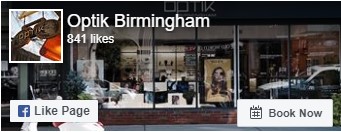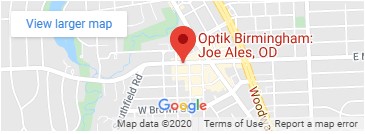
Dr. Joe Ales continues to offer thorough, thoughtful, comprehensive eye examinations. Updating his instrumentation through the years allows him to offer eye exams that go beyond the minimal “standard of care” requirements. For instance, the OCT* instrument is quick and easy (on the patient) and helps with early detection, ruling out conditions in suspicious cases, and creates a data base of the retinal integrity for future comparisons. This testing capability and others Dr. Ales offers is important since many serious eye and general medical conditions can have very subtle to no early warning symptoms. Please know Dr. Ales and his conscientious opticians and technicians offer a comfortable environment, with a commitment to quality up-to-date care for you and your family.
Book an Appointment Online Today.
The Comprehensive Eye Exam
Corrective Lenses Prescription
Your health and family health history, your eyeglasses and contact lens history, and a thoughtful discussion of your vision concerns are a significant part of your eye examination. At OPTIK, Dr. Ales’ scheduling allows for ample time. His explanations clarify the importance of what he’s assessing and why. Patients recognize his thoroughness and say this helps them appreciate recommendations from him and the OPTIK team. Be assured … he won’t bore you, either!
Dr. Ales works with only the most advanced instrumentation that makes your experience more comfortable. This also gives him excellent documentation of your external and internal eye structures, and your health, on examination day. The best way to assess your eye health in the future is to use today’s results as a baseline. And know this: an eye exam is not a stressful experience. Dr. Ales’ eye chart doesn’t even use all of the 26 letters of the alphabet.
External Evaluation
A careful bio-microscopic evaluation gives Dr. Ales a magnified view of your outer eye structures: lids, tear glands, conjunctiva, iris, sclera, cornea and lens. In minutes, Dr. Ales determines if a “pink eye” is viral, allergy related, bacterial or from a foreign object. Some little growths on eyelids are common and benign; some are serious. The lens gets more rigid with age, losing its ability to focus and leaves us needing reading glasses. Not stopping there, it begins to yellow and cloud … becoming a cataract. Finally, dry eyes — the most common eye complaint in the country — are treatable. Some tips: Drink more water, eats lots of leafy green vegetables … blink!
Of course, there are external eye conditions too numerous to list here. But some less obvious signs, like pigment dusting on the internal cornea, though not dangerous to the cornea, can make someone at risk for developing glaucoma. Let’s take a look.
Internal Evaluation
Dilated pupil evaluations are the standard of care. However, pupil dilation drops affect focusing, too, making it difficult to work on a computer or see your phone for about three hours. If you’re concerned about work that day after your exam, Dr. Ales can determine a glasses prescription, assess your external eye health and, if not urgent, he can look at your internal eye structures un-dilated. However, an un-dilated view is a limited view, and he highly recommends our no charge re-appointment, at your convenience, for a dilated pupil retinal assessment. This is an absolute must for diabetics, and anyone with high near-sighted eyes, or other urgent concerns.
Further, Dr. Ales has instrumentation to detect subtle changes in eye tissue integrity and early signs of macular degeneration, diabetic retinopathy, optic nerve swelling, glaucoma and other conditions. This allows him to make determinations on exam day, avoiding the need to refer patients. However, when necessary, Dr. Ales directs patients to appropriate secondary care with retina, glaucoma or external eye specialists.
A few more tips: Eyes are structurally fully developed at an early age. To have data and imaging, even for a young healthy eye, is advantageous for future assessments, namely, of glaucoma, well into adulthood.
And consider: Many people who enjoy strong distance vision may not go to the eye doctor until it’s too late. Then, when they need reading glasses they simply buy readers at a local pharmacy. They tend to not see an eye doctor until their distance vision changes, which could start at, say, 55 years old. Data suggests 2.5+% of those people have glaucoma, and possibly have had glaucoma for many years. Glaucoma and macular degeneration are behind only diabetic retinopathy as leading causes of blindness in the United States. Don’t hesitate… make an appointment now.
Services Above the Standard
Optical Coherence Tomography (OCT)*
Non-invasive, non-contact, and quick and easy, this instrument uses light waves to create a 3-D
Hi-resolution image of the retina and the anterior eye. The OCT gives Dr. Ales invaluable information that he can use to follow patients with known conditions, to detect conditions early, and as stated earlier, to create a data base of information. This information can be passed on to other eye care providers should the patient change residence. To the relief of a number of our patients, the OCT scan results at OPTIK eliminated the need for Dr. Ales to refer them to another specialist doctor.
Glaucoma Screen Pressure Check
At OPTIK, gone are the days of patient fear and trepidation of the dreaded “Puff Test.”
A few years ago, Dr. Ales acquired a new technology instrument that is super-fast, accurate, and requires no eye drop because you feel nothing!
Retinal and Anterior Eye Imaging
A digital image of the eye structures – retinal vessels, the macula, optic nerve – allows for a global view of those structures and helps with the same day assessment. Simply put, a digital image taken today is better to compare to in future eye exams than written notes only.
Visual Field Testing
Visual field testing measures the entire area (field of vision) that a patient can see while focusing on a single point. There are different types of visual field tests ranging from a gross analysis of detecting a doctor’s hand movements, to sophisticated instruments that determine the extent and depth of visual field loss. At OPTIK, we use our instrument when Dr. Ales feels more precise fields data is necessary. Glaucoma is a leading cause of blindness in the USA and the world, and visual field testing is crucial in diagnosing, evaluating and monitoring glaucoma and other visual field effecting conditions.
Zeiss i-Scription
Many patients having difficulty with their vision at dusk or night time can benefit from
a glasses prescription made to the one hundredth, .01 increment, rather than to the standard
of a quarter .25, increment. The instrument formulates a precise prescription it derives from its measurement coupled with Dr. Ales’ refraction (the “what’s better one or two?’ part).
On-Site Lens Finishing Lab & Optician
OPTIK has the same machines big optical labs use to “cut and edge” prescription lenses to your eyeglasses frame. Our opticians have many years of experience and can put new lenses in a used frame, a new frame, a vintage frame, a rimless frame, etc. – which allows for excellent quality control. Please know, when necessary we use only the best optical labs, and we hold them to the highest standard as well.
Eye Exam Q&A
What is a comprehensive eye exam?
A comprehensive eye exam is a multi-part evaluation designed to assess your visual acuity as well as your ocular health. A comprehensive eye exam is a multi-part evaluation to which Dr. Ales allows an unhurried 30 minutes, or more if necessary, to address your particular concerns while assessing your visual acuity and ocular health. Common eye conditions and disorders include:
- Macular degeneration
- Glaucoma
- Cataracts
- Diabetic eye disease
- Dry eye
- Low vision
Having regular comprehensive eye exams as recommended is essential to catching these conditions early on before they cause any noticeable symptoms. In many cases, early detection and treatment can help you avoid a serious degree of vision loss or even blindness in one or both of your eyes.
What does a comprehensive eye exam cover?
A comprehensive eye exam is designed to cover every aspect of eyesight and eye health. Before the exam itself, you’ll discuss your medical history, overall health, and current vision issues with Dr. Ales. Then, he’ll check on the following:
Retina and Optic Nerve Health
After dilating your eyes with drops, Dr. Ales examines the back of each eye to look for signs of damage or disease that may affect your retinas or optic nerves. Using an optical coherence tomography (OCT) scan, an advanced imaging test that captures high-resolution 3-D images of your retina and optic nerve, he’s able to spot serious eye diseases before they cause noticeable symptoms.
Visual Acuity
This standard eye test involves reading from an eye chart to assess how well you see at various distances.
Eye Pupil Reaction
Dr. Ales shines a specialized light into each eye to evaluate your eye pupil response. Pupils that don’t change or become larger may indicate an underlying problem.
Side Vision
When testing your side vision, Dr. Ales is mainly looking for early signs of glaucoma, a disease that damages the optic nerve and often begins with a loss of peripheral vision.
Eye Movement
Evaluating your eyes’ ability to track objects and move quickly in all directions is a good indication of proper eye alignment and ocular muscle function.
Eye Surface
Dr. Ales looks at the front part of each eye with an illuminated microscope to evaluate your eyelids, corneas, irises, and lenses. This part of the exam can help him identify cataracts, scars, or scratches.
Vision Test
Finally, if you require vision correction, your exam also includes a vision test to determine your individual prescription for eyeglasses or contact lenses.
When should I have a comprehensive eye exam?
Most adults should have a baseline eye exam by the age of 40 when early signs of disease typically begin to emerge and changes in vision are common.
If, however, you have certain risk factors for eye disease, including diabetes, high blood pressure, or a family history of eye disease, you should see an optometrist before the age of 40. To catch age-related eye problems early, people who turn 65 should have a comprehensive eye exam every two years.
To schedule your next eye exam, call Optik Birmingham today or book an appointment online any time.



